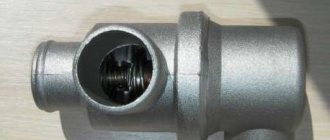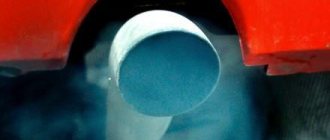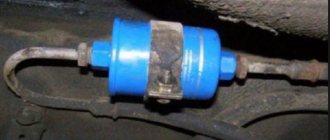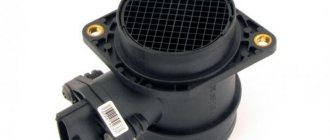VAZ 2110 marked the beginning of a whole family of cars. Some of them are still in production today. This model range is characterized by high reliability and relative simplicity of execution, which is one of the main reasons for the high popularity of the car. However, long-term operation has revealed a number of significant shortcomings. One of them is the cooling system.
It works great on a relatively new car, however, as soon as the service life exceeds 10 years, malfunctions appear in its operation. They ultimately manifest themselves in the same way. The arrow of the device indicating the temperature invariably creeps up. There may be several reasons why the VAZ 2110 engine heats up, and this problem requires detailed consideration.
The engine of a VAZ 2110 is overheating and what should I do?
VAZ 2110 marked the beginning of a whole family of cars. Some of them are still in production today. This model range is characterized by high reliability and relative simplicity of execution, which is one of the main reasons for the high popularity of the car. However, long-term operation has revealed a number of significant shortcomings. One of them is the cooling system. It works great on a relatively new car, however, as soon as the service life exceeds 10 years, malfunctions appear in its operation. They ultimately manifest themselves in the same way. The arrow of the device indicating the temperature invariably creeps up. There may be several reasons why the VAZ 2110 engine heats up, and this problem requires detailed consideration.
Car cooling system
The cooling system is made according to the classical design. The coolant circulates in large and small circles. Its transition from one circle to another is carried out automatically using a thermostat. The antifreeze is cooled in a radiator, which is made of aluminum for better heat transfer.
To prevent engine overheating during long-term operation in low gears, the car is equipped with a fan that turns on automatically when the temperature reaches a certain value. The main causes of malfunction of the VAZ 2110 car:
- thermostat failure;
- the fan does not work;
- airlock;
- coolant level is low;
- dirty engine surface.
Any of these reasons may cause the engine to become very hot. As a result, the machine will lose a significant part of its power.
Removing contaminants
In summer, various pollutants can significantly clog the radiator grille. Naturally, air cooling processes will not be as efficient. As the coolant cools in the radiator, this process also worsens.
Preventive action is cleaning the radiator. Paint that peels off honeycombs also causes this effect.
You can rinse the radiator thoroughly at a car wash. The jet from the Karcher sink should not be brought near the radiator honeycombs. Water or other water-based solutions will form scale.
When such compounds are oxidized, various impurities appear. Sand and dirt can easily cause the radiator to clog from the inside. What to do?
Flush the entire cooling system completely. As a result, we will see cloudy and dirty coolant.
Return to contents.
Thermostat and fan malfunctions
A symptom of a faulty thermostat is a sudden increase in temperature for no apparent reason. That is, the car engine was operating in normal mode, there was no long standing in traffic jams or driving in first gear, and the instrument needle was close to the critical mark. Why is this happening? The fact is that, as a rule, the thermostat gets stuck in the closed position.
In this case, the liquid continues to circulate bypassing the radiator, which is not enough to cool the engine. Determining whether the thermostat is really at fault is very simple. It is necessary to warm up the engine to a temperature of 90 °C. Now you should evaluate the temperature of the pipe that goes to the radiator. If it is cold, the thermostat must be replaced.
Unlike the previous case, engine overheating is preceded by prolonged operation in low gears. In this mode, the VAZ 2110 radiator does not have sufficient airflow and when the temperature reaches 95 ° C, a sensor is triggered that turns on the fan. If this does not happen, engine overheating is inevitable. Such damage is complicated by the fact that faults, in addition to the fan itself, can occur in its power supply circuit.
As a special case, a blown fuse should be mentioned.
In addition, the sensor itself may fail. This is why it is so important to correctly identify the faulty unit. You can do this as follows. It is necessary to close the contacts of the sensor; it is installed on the radiator. Be careful when performing this operation. The engine must be turned off and the ignition turned on.
If the fan motor starts to spin when the contacts are closed, the sensor is faulty. If not, then the problem may be in the fuse and you need to check it. If it is in good working order, further repairs require skills and the presence of a special device, so it is better to contact a specialist.
Prevention
From time to time, you should prevent engine overheating in order to avoid unpleasant situations in the future. In terms of costs, this costs little money, but in the end it can save the engine from breakdown. You can identify the “weak link” by eliminating, gradually checking suspicious parts for malfunction.
In addition, overheating of the engine can occur if the wrong mode of operation of the motor is selected. For example, if you constantly drive only in lower gears and at high speeds, then the likelihood of the engine boiling increases, especially if there are deviations in the operation of the cooling system. In the cold season, some errors are not affected by low temperatures, but this does not mean that engines boil only in the summer.
content .. 14 15 16 17 ..
Air lock and coolant level
In this case, overheating is preceded by some action with the coolant. This could be draining it for repairs or completely replacing it. An air lock formed in the system prevents normal circulation.
You can try to get rid of it by slightly raising the front wheels of the car. To do this, the car must be placed on a hill, after which it must be allowed to idle. If this does not help, then you need to do the following:
- remove the return pipe from the throttle assembly;
- it is necessary to fill the reservoir with coolant;
- start the engine and wait until antifreeze runs out of the remote control fitting, then plug it with your finger;
- Now you need to wait until the liquid comes out of the hose, and then put it in place.
Here it is appropriate to say one more thing. The systematic formation of air jams can be associated with a very unpleasant malfunction - damage to the cylinder head gasket. But this requires the intervention of specialists and can seriously hit the wallet.
Overheating of the VAZ 2110 engine can be caused by a lack of coolant. This can happen for natural reasons, due to its evaporation or, more often, in the event of a leak. Over time, the tightness of the seals is broken and rubber parts lose their elasticity. All this leads to antifreeze leakage. If the problem is not corrected in time, it can lead to serious damage to the power unit.
A dirty surface is a common cause of engine overheating. It's no secret that power units whose mileage has exceeded 200,000 km are usually covered with an oil film on which a thick layer of dust settles. This impairs engine cooling by air flows that circulate in the engine compartment.
To exclude such a development of events, it is necessary to carefully seal all connections of the power unit. In addition, you need to systematically remove oil stains from it. In addition to the engine, the radiator itself may become dirty. This, naturally, will also worsen cooling, and the motor may begin to get very hot. In this case, it is necessary to carefully blow out the radiator with a compressor.
The engine of the VAZ 2110 car has a simple design and a long service life. However, we must not forget that for normal operation it requires appropriate care and systematic maintenance.
How to determine if the engine is overheated
At first glance it seems very simple - according to the indicators of the engine temperature device, or - sensor. This is true, if not for one thing - novice motorists are so captivated by the road situation around them that they look at the instrument panel only in one case - how much fuel is left. Experienced motorists, on the contrary, due to their confidence in their abilities, also do not look at the car’s dashboard. And as a result, a situation often arises that overheating is detected when the engine temperature has long exceeded permissible limits, and irreparable damage has been caused to the engine. It is irreparable overheating that is one of the most complex malfunctions, which leads to very serious consequences. But more on that later. But there is a way that will not let you miss the moment of overheating. This is problematic in a traffic jam, and is not always clearly present, but here’s what you should be aware of:
— As soon as the engine temperature exceeds the permissible norm, when you sharply press the gas pedal, or when accelerating the car, even slightly, detonation knocks are clearly heard , which are popularly called “tapping fingers.” This is not true, but everyone knows this definition. If you hear such a sound, there is a 99% chance that the engine has overheated, and action must be taken.
Detonation knock is a loud metallic knock, the frequency of which coincides with the engine speed. You've probably heard such sounds when refueling with low-quality fuel. I personally don’t know where the concept of “tapping fingers” came from.
But the real reason for such knocking noises is a disruption in the fuel combustion process. What you hear is nothing more than explosions of the fuel mixture. During normal engine operation, the combustion process is controlled, but as soon as one of the operating parameters is violated, the process goes out of control and combustion turns into an explosion.
Hence the concept - detonation (from the word detonate - explode) knocks. When the engine overheats, this is the first sign.
Before continuing the conversation, let's define what is normal temperature and what is overheating. There is no one-word answer, but there are general rules. The engine temperature is within 85-95 degrees Celsius, which is working.
Engine temperature up to 100 degrees is acceptable. This means that a short-term increase in temperature to 100, sometimes up to 105 degrees is allowed. Just for a short time - up to 5 minutes.
Engine temperature above 105 degrees Celsius means overheating and action must be taken.
Common Causes
As you know, the VAZ 2110 is equipped with two types of engines - with 8 and 16 valves. There are several main, most common reasons that cause this overheating of power units.
Let's look at each of the reasons and ways to resolve these problems separately.
Tens engine
Low coolant level
Coolant plays a huge role in the operation of the cooling system. A special substance, namely antifreeze or antifreeze, is poured into the expansion tank.
Related material:
In a normal situation, the level of the coolant solution should be at the level of, or rather the MAX marks on the tank body. This indicates that the container is approximately 50-60 percent full.
If there is no such mark on the tank, refer to the clamp. The liquid should reach its upper edge.
- If the engine overheats, try simply adding the missing amount of coolant so that it is at the optimal filling level.
- If you have not changed the coolant for a long time, it is better not to add new coolant, but simply replace it completely with new coolant.
- When choosing between antifreeze and antifreeze, most VAZ 2110 owners prefer the first. And mainly due to the financial availability of antifreeze. But in practice, antifreeze is better . One of its most important advantages is that the substance does not freeze in severe frosts. For individual regions of our country, this is a key factor in the choice of coolant.
Thermostat
Another reason for engine overheating is a stuck thermostat valve. If it remains in the closed position and does not open, the coolant will move only along a small circuit. As a result, this will lead to strong heating of the power plant. Overheating itself threatens with very, very serious consequences.
Such a malfunction can manifest itself at the most inopportune moment - on the road. You are unlikely to be able to carry out high-quality repairs on the side of the road. But you can try one method - knock on the thermostat housing. Often this allows you to return the device to its functionality for a while. This way you can get to your own garage or the nearest service station. There the thermostat has already been replaced with a new one. There is no point in repairing it. If he failed once, the situation will certainly repeat itself soon.
Related material:
Thermostat in the engine
temperature sensor
A temperature sensor is necessary in order to respond to changes in engine heating. When a preset point is reached, the sensor is triggered and turns on the cooling fan.
If this device malfunctions, the power unit overheats because the fan does not activate. Consequently, the temperature does not fall below critical levels, but continues to gradually rise.
Related material:
If you encounter such a problem on the road (most often the engine overheats while stuck in traffic jams, since the engine is running but there is no flow of cooling oncoming air), try to get out of the jam as quickly as possible and find a free section of the road.
Accelerate during the free stretch and then begin engine braking. This will lower the temperature and prevent overheating. Under no circumstances should you regularly operate your car this way. But this is a great way to get to a garage or auto repair shop, determine the cause of the sensor failure, and then replace it.
Cooling Fan
The symptoms of fan malfunctions are similar to a non-working temperature sensor. That is, the engine will heat up, the indicator on the dashboard will be in the red zone.
Related material:
Again, while on the road, we recommend using the engine braking method. Next, head to the garage. Let the car cool down. In the meantime, go to the store for a new fan. This device for the VAZ 2110 costs about 600 rubles.
Fan problems
Other reasons
There are other equally popular reasons for engine overheating. Therefore, we invite you to familiarize yourself with all of them in our table.
Cause of overheating
Remedy
Coolant level too low
Add coolant to the required level, following the marks or clamp on the expansion tank
The radiator is clogged or blocked
Flush the radiator. If this does not help, the unit must be replaced
The cooling system pump has failed (the impeller slips on its internal shaft)
It's best to replace the pump
The oil level in the lubrication system is critical
Add oil to the required level. If it is old, change the oil
The ignition timing is incorrectly set
Perform torque adjustment
The thermostat has failed
Replace the device with a similar new one
The cooling fan motor has failed
It can be repaired, but it is better to install a new motor
When faced with such a phenomenon as engine overheating, do not rush to send your VAZ 2110 for repair to a car service center. You can find many causes of overheating with your own hands and deal with them yourself. Service station services are not cheap these days, unfortunately.
Consequences
The consequences can be different, from fairly insignificant to such that the engine can be safely sent to a landfill.
The severity of the consequences of engine overheating directly depends on the actions of the driver himself. The sooner he takes action, the cheaper it will be to eliminate the consequences.
- If the engine runs for less than 10 minutes under extreme loads and conditions, nothing bad should happen. Domestic units are reliable enough to withstand this. In the worst case, the piston surfaces will melt slightly.
- If the engine runs in this mode for more than 20 minutes, more serious consequences should be expected. Most often, cracks form in the cylinder head, it becomes bent, the gasket burns out, the seals are damaged, the inter-ring partitions are deformed, and so on.
- If overheating is completely ignored, the consequences will be tantamount to disaster. First, the combustion chamber will fail, the engine will stop responding altogether, and the piston system will melt.
- When the oil overheats, it loses its lubricating properties, and therefore active friction of moving parts begins.
The most dangerous thing is a connecting rod breaking through the cylinder block wall. If this situation happens, your engine is finished. Look for a new one.
Always check that the coolant reservoir is full
By exercising proper control over the condition of the cooling system, and carrying out all technical work on time to maintain its proper operation, the problem of overheating of the VAZ-2114 power unit will never appear, which will extend the life of the power unit.
Why the VAZ-2110 injector engine does not heat up: reasons
Cars from the domestic manufacturer AvtoVAZ have been leaders in the Russian market for many years, and this applies to both new cars and used vehicles.
This is due to the fact that the income level of the vast majority of people allows them to purchase and subsequently maintain economy class vehicles. The VAZ has no obvious advantages, but if you remember its shortcomings, perhaps there are not enough fingers to list them all. Starting from the ambiguous design and ending with all possible problems with all units, there is nothing in Togliatti cars that users have not yet scolded them for. Nevertheless, they continue to be bought, despite their shortcomings, and all because it is precisely as a means of transportation that takes people from point A to point B that they perform their function quite satisfactorily. The most popular models are the same old “sevens”, “eights” and “nines”, which have been coming off the assembly line in the same form since the early 80s to the present day.
Often the consumer's choice falls on the VAZ-2110, their follower. It is especially often taken as a first car, which, as they say, “is almost a shame,” or as a second car in the family, when you don’t want to use a good car due to weather conditions, bad roads, or the need to transport something dirty, sticky and smelly. In any case, so that all sorts of troubles in the form of technical malfunctions subsequent to the purchase do not come as a surprise, you need to first familiarize yourself with the most frequently encountered problems. One of them has been seen more than once in discussions on numerous auto forums and heard from the lips of hardened car enthusiasts even by those who have not heard about the VAZ-2110 specifically before - the engine does not heat up.
What to do
If you find a need to change any of the listed components, you should not save on them.
Spare parts for the VAZ-2110 are already not too expensive and durable to look for some analogues of even more dubious quality. Fortunately, the replacement is carried out quickly, since the design of a domestic car will not require lengthy discussions about where and what is located. You can perform the procedure without contacting specialists at a service station. But it’s better to have your car diagnosed by them in order to determine exactly what is causing the problems with warming up the internal combustion engine and what needs to be replaced. By the way, there is no need to try to repair worn or damaged engine parts on a VAZ-2110. It will be much cheaper to simply buy a new spare part; repairs in this case are just a waste of time, effort and money.
How to fix the problem
The logical solution to the problem, in this case, is to replace either the thermostat itself or the component thermoelement. Both options are quite cheap, since we are talking about a domestic manufacturer, there is no need to buy any analogues. This procedure can easily be carried out independently, but if you do not know the technical component of the VAZ-2110, it is still better to contact specialists at service stations. The most important thing is to first drain all the antifreeze in the system.
As a result of the replacement, the car’s instrument scale should show an engine temperature of at least 90 degrees after 20-30 minutes of warming up or 10-15 minutes of driving without prior waiting. The thermostat scale must be monitored periodically, at least once every 15 minutes of travel. A quick glance is enough to ensure that the engine temperature is within the required range, which will automatically indicate the integrity and suitability of the thermostat itself.
Long warm-up can also be a consequence of incorrectly selected antifreeze for the cooling system, but such cases, as practice shows, are rare.
Main causes of overheating
The classic cooling scheme consists of a large and small circuit through which antifreeze circulates. The thermostat performs a regulatory function, directing the liquid in the desired circle. It is cooled in a radiator made of aluminum. The fan built into the system turns on while the car is running at low speeds, helping to maintain the required degrees.
When the engine of a VAZ 2110 gets hot, the reason lies in the following malfunctions:
- The thermostat is malfunctioning;
- the fan has failed;
- an air lock has formed in the cooling system;
- insufficient coolant level;
- antifreeze boiling;
- dirty engine.
Each of these reasons can become the main reason why the VAZ 2110 engine begins to overheat. As a result, the car loses power.
Thermostat malfunction
If the VAZ 2110 8-valve injector heats up, the reason may lie in a faulty thermostat. The unit is jamming. As a result, the circulation of liquid stops at any temperature. Often such a breakdown is caused by the fact that the VAZ 2110 car heats up for a long time at idle. The time of such warming up should not exceed 10 minutes. It is allowed to drive the car immediately after turning it on, provided that the first few km it is given a gentle mode.
Thermostat: 1-bypass valve; 2-outlet pipe (to the pump); 3-main valve spring; 4-main valve; 5-piston holder; 6-piston; 7-inlet pipe (from the radiator); 8-rubber insert; 9-solid heat-sensitive filler; 10-bypass valve spring; 11-inlet pipe (from the engine).
The thermostat can be checked directly on the engine. The operating procedure is as follows:
- The engine starts.
- The instrument needle begins to move upward.
- The radiator pipes located under the hood, top and bottom are checked. If the lower one becomes warm before the gauge needle starts moving, it means the thermostat is stuck in the open position. When it is permanently closed, the bottom pipe remains cold at any temperature.
You can also check the thermostat by dismantling it and understand why the VAZ 2110 8 valve engine heats up . To do this, the device is removed from the engine and placed in a container of water. This could be any saucepan that is placed on the fire. After the liquid boils, the valve should open. If this does not happen, then the unit is jammed. It cannot be repaired. It needs to be replaced.
Fan problem
If the VAZ 2110 8-valve injector heats up, the reason may lie in a non-working fan. This is a car component whose function is to cool the liquid in the radiator. The signal to turn on the electric motor is supplied by the sensor. This happens when the temperature exceeds the permissible threshold.
If the fan fails, then the VAZ 2110 with an injector begins to heat up for the following reasons:
- The thermostat valve is stuck. The coolant will constantly circulate only in a small circle, without entering a large one. Antifreeze will stop flowing into the radiator and will not reach the temperature sensor. As a result, the antifreeze will begin to boil.
- When the VAZ 2110 engine starts to heat up quickly, the reason may lie in a faulty fan drive itself. For testing purposes, it is connected directly to the battery. If it does not turn on, it means the drive needs repair.
- Before you start checking the drive, you need to inspect the fuse. His brand is F-7. The operation of the element is checked with a multimeter. The burnt out part is replaced with a new one.
- Fan relay failure. To get to it, you need to remove the center console cover in the installation compartment. The cooling relay is located on the left edge. It can only be checked by installing a new element. Then the VAZ engine warms up and the new part is monitored.
- A wiring break causes the fan to turn off. The break point is located using a tester. A new wire is being laid in this area.
Air lock in the cooling system
When antifreeze boils in the expansion tank of a VAZ 2110, the reason may be an air lock.
VAZ-2110 engine cooling system (with carburetor): 1 — heater radiator; 2 — steam removal hose of the heater radiator; 3 — outlet hose; 4 — supply hose; 5 — coolant temperature sensor (in the block head); 6 — pump supply pipe hose; 7 — thermostat; 8 — filling hose; 9 — expansion tank plug; 10 — coolant level indicator sensor; 11 — expansion tank; 12 — exhaust pipe; 13 — liquid chamber of the carburetor starting device; 14 — radiator outlet hose; 15 — radiator supply hose; 16 — radiator steam hose; 17- left radiator tank; 18 — sensor for turning on the electric fan; 19 — fan electric motor; 20 — electric fan impeller; 21 — right radiator tank; 22 - drain plug; 23 — electric fan casing; 24 — timing belt; 25 — coolant pump impeller; 26 — supply pipe of the coolant pump; 27 — supply hose to the liquid chamber of the carburetor starter; 28 - outlet hose.
Antifreeze is boiling in the expansion tank
Why does antifreeze boil? This question is asked by many motorists who have encountered this phenomenon while driving a car. There are many reasons why antifreeze can boil, as well as ways to eliminate them.
- Cause 1. The coolant level in the expansion tank is too low. This happens if antifreeze was poured in insufficient quantities. Its level should be between the “min” and “max” marks on the tank body. However, it is also possible that there is a coolant leak, which can be anywhere. After eliminating the leak, simply pour the missing amount of antifreeze into the tank.
A leaky system can also cause boiling, since there is no normal pressure in the cooling system. Therefore, it is imperative to eliminate leaks and any other damage in the cooling system. The exception is the expansion tank cap. The holes in it are designed to release excess pressure so that the tank does not burst.
Video - Why does antifreeze press into the expansion tank?
- Reason 2: The engine cooling fan does not work. This is especially true for modern cars that are equipped with electric cooling fans. The essence of the operation of this device is extremely simple: when the antifreeze reaches a certain temperature, the temperature sensor is activated and closes the circuit for turning on the electric fan. As it cools, the temperature drops and the sensor turns off, opening the fan circuit. Thus, the cooling process is automated, which can be disrupted by two factors: breakdown of the fan motor and failure of the sensor itself.
To diagnose this malfunction, you can do the following test: as soon as the coolant temperature reaches above 100 degrees, pay attention to the condition of the fan. If it doesn't work, first check if it works. To do this, short-circuit both wires that connect to the fan sensor and if the fan does not start rotating, it means that the breakdown has affected the electric motor. In this case, you can replace only the motor or the entire fan.
If the fan works, then the failure lies in the temperature sensor. Drain the antifreeze and replace the sensor with a new one.
- Reason 3. Formation of an air lock in the cooling system. An air bubble in the cooling system interferes with the normal circulation of coolant. An air lock is a common occurrence and occurs after replacing antifreeze. To remove it from the front to the top, unscrew the radiator cap and start the engine. Ask an assistant to vigorously press the gas pedal, while you yourself, at this time, press the cooling system pipes until the bubbles appearing in the radiator disappear. After this, tighten the plug and add coolant to the nominal levels.
- Reason 4. Low quality coolant. It is the most common problem of drivers who “save” on antifreeze. The fact is that low-quality antifreeze, purchased from an unscrupulous manufacturer at a low price, is diluted with water. And since the boiling point of water is lower than that of antifreeze, this means that there is a risk of boiling. This happens especially often when the engine is stopped.
- Reason 5: Cylinder head gasket. A burnt-out gasket also often causes antifreeze to boil, as it breaks the tightness of the cooling system. To determine its malfunction, you can start the engine and ask an assistant to slowly move under load. If air bubbles appear in the tank, this is a clear sign of a faulty gasket, which can only be replaced. There may also be coolant residues in the vehicle exhaust. At the same time, the antifreeze level is significantly reduced.
- Cause 6. Other cooling system problems. These include: a water pump from another manufacturer, increased contamination of the radiator and lack of normal air flow. The last malfunction is often found in fans installed on the water pump. If you use such a fan without a special casing, it will blow hot air that is collected from the engine compartment. Therefore, the use of a casing on such a fan is mandatory.
In the case of a water pump from another manufacturer, its blades may be noticeably smaller than normal, which is why there is a lack of pressure in the system. It just needs to be replaced, however, diagnosing such a malfunction is quite problematic.
If the radiator is very dirty, wash it with a stream of water under high pressure. This procedure has a noticeable and positive effect on the engine cooling process.
- Reason 7: Thermostat malfunction. The thermostat, at a temperature of approximately 90 degrees, opens the valve and “passes” coolant to a large circle of the cooling system. It happens that the valve simply does not open and the liquid moves only in a small circle, which causes boiling. Diagnosis of such a malfunction is made by measuring the temperature of the large circle pipes. If they are cold, then the fault has indeed affected the thermostat and it needs to be replaced.
- Reason 8. It's time to change the antifreeze. This is the safest reason for boiling. The fact is that antifreeze tends to change its chemical composition during prolonged use, which certainly leads to a change in its boiling point, as well as a deterioration in its cooling properties. In this case, it just needs to be replaced.
Cooling system and consequences of overheating
The VAZ 2110 injector engine is heating up, which means that the cooling system is working with impaired fluid circulation, since ideally unhindered circulation contributes to the optimal operation of the internal combustion engine. Delay in repairs
can lead to serious breakdowns and significant expenses for the purchase of spare parts and components.
As a rule, the pistons suffer
, various levels of bearings, valve stem seals and rings. Engine detonation often occurs as a result of burnout points inside the unit. And the worst option may be a burnout of the cylinder head, which will lead to major repairs, and this is by no means a cheap pleasure and the end result may not always please the car enthusiast.
There are cases where a major overhaul of a power plant did not live up to expectations. It is not for nothing that experienced drivers believe that an engine is considered an engine until it begins to “prick” it. This applies to both motorcycles and four-wheeled cars.
What to do if your car overheats in a traffic jam
When driving a car for a long time in a lower gear, the engine operates with increased power, which in itself leads to overheating. Add to this the lack of oncoming air flow necessary to cool the radiator. What to do?
The main thing is not to panic. Short-term overheating is not terrible, but if you see that the car is not cooling down, it’s time to act.
Important - do not turn off the engine unless absolutely necessary. Exactly - without extreme. A stalled, overheated engine is an almost 100% guarantee of repair. It will take quite a long time to describe what is happening in the engine in this case (rotating the liners together with the crankshaft, when the engine is subsequently started - the least of the possible troubles), just take it on faith.
Important - do not think about pouring water on the engine or pouring cold water into the radiator. The result is the same - repair. Moreover, you can try so hard that you cannot do without replacing the block and cylinder head. Another “beauty” of cold water is microcracks inside the block. Finding and eliminating will be very, very difficult, if not impossible. The car has overheated - try to pull over to the side of the road. If it doesn’t work out, don’t panic and don’t pay attention to those around you – it’s important for you to save the engine. Stop at idle, turn the heater on full, and wait. If after 5-10 minutes the situation does not improve, turn off the engine.
It’s a good idea to open the hood; the main thing in a panic is not to forget to set the car’s parking brake. The only reason to turn off the engine right away is clouds of steam coming from under the hood. Most likely, the cooling pipe has burst, and further operation of the engine will only worsen the situation.
This is what it looks like, engine overheating, if you look closely. Now you know why the engine gets hot and how to deal with it. Author: Igor
With the arrival of warmer weather, many drivers are faced with poor performance of the VAZ cooling system when the VAZ 2114 engine gets very hot. There are quite a few reasons why the engine overheats. You need to understand the reasons and find out ways to combat overheating.
Return to contents.
Driver signals
A specially equipped sensor in each vehicle will currently help to systematically monitor or monitor the temperature of the liquid in the cooling system. In more modern cars it can be slightly modified and display indicators using LEDs, but the essence does not change, the purpose remains the same - to help the driver in signaling the readings.
Now the physical side of the “coin”. Even from driving school, we know that an automobile cooling system consists of large and small circles through which some liquid or water circulates. When starting the engine and up to 90°C
the liquid flows in a small circle, from 90°C and above the thermostat opens and allows flow in a large circle to reduce the overall temperature by lengthening the flow chain.
Accordingly, breakdowns in the thermostat can lead to its failure to open in a timely manner and the coolant to boiling. This means expect a “hello” from the piston rings.
Faulty sensors
The engine temperature shown on the dashboard is data from a sensor installed on the engine. The sensor from which the readings are transmitted to the computer determines the temperature of the antifreeze in the thermostat. To control the engine, data from the coolant temperature sensor (coolant temperature sensor), a sensor next to the thermostat, is used.
If the VAZ 2114 does not heat up and there is a possibility that the sensors are faulty, it is better to contact a car service center to have their operation checked by a qualified technician.
Thermostat replacement algorithm
- Unscrew the cap of the expansion tank to avoid a vacuum;
- Drain the coolant or water, depending on what is poured into the radiator;
- We dismantle the pipes by loosening the clamps;
- Unscrew the old faulty thermostat;
- We clean the surface for mounting serviceable equipment from the remains of old sealant or paint;
- We apply a new, heat-resistant sealant along the contour of the seat, both on the engine and on the thermostat itself;
- We wait a couple of minutes until the sealant begins to set;
- We begin the process of installing the thermostat;
- We connect all the necessary pipes;
- Fill in coolant. In this case, you can use the old one, if it is clean, or the new one.
- We start the car and check the system.
Sources:
https://expertvaz.ru/2110/greetsya-dvigatel-avto.html https://luxvaz.ru/vaz-2110/153-greetsya-dvigatel.html https://ladaautos.ru/vaz-2110/pochemu- ne-greetsya-dvigatel-inzhektor-vaz-2110-prichiny.html https://vaz-2110.ru/dvigatel/pochemu-greetsya-vaz-2110-inzhektor-8-klapanov-prichina.html https://autoflit. ru/461-silno-greetsya-dvigatel-vaz-2110-inzhektor-problema-reshaema.html
What not to do when the engine is boiling
There are a number of strict rules that limit the driver’s actions during a situation when antifreeze boils in the radiator, expansion tank or other element of the cooling system. These rules are designed to protect human health from causing serious injury, and to minimize material losses that may arise in the described situation.
- Do not load the engine (do not accelerate, but instead you need to reduce the speed to idle as much as possible, usually around 1000 rpm).
- Do not stop abruptly and turn off the engine, thinking that the engine will stop boiling; on the contrary, everything will only get worse.
- Do not touch hot parts in the engine compartment!
- While steam is coming from under the cap of the expansion tank or other unit and while the antifreeze is bubbling in the system, you should absolutely not open the cap of the expansion tank! This can only be done after the time specified above has passed.
- Do not pour cold water on the engine! You need to wait for the engine to cool down on its own.
- After the engine has cooled down and new antifreeze has been added, you should not drive after the temperature reaches more than +90 degrees.
Compliance with these simple rules will ensure the safety of the driver, and also minimize the degree of breakdown and, consequently, possible material costs.











